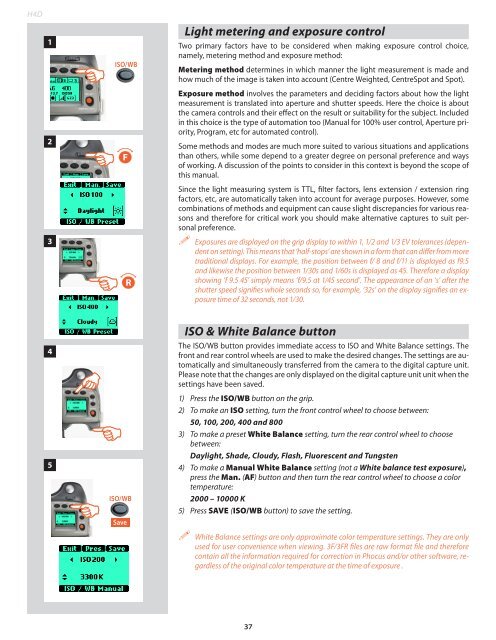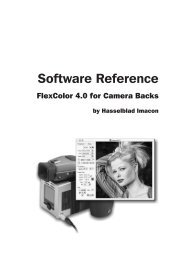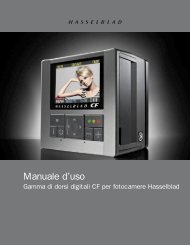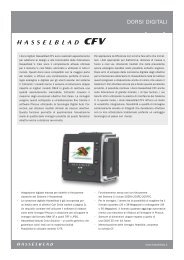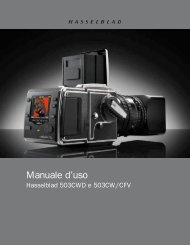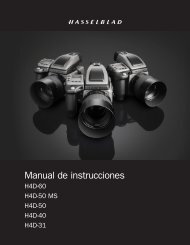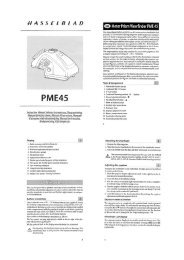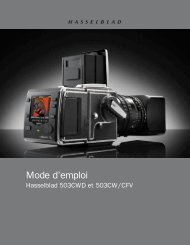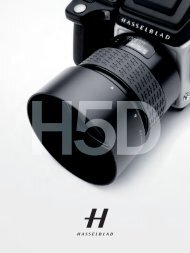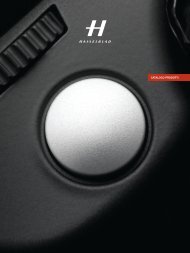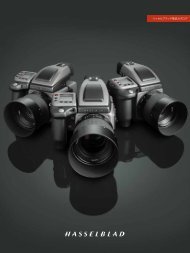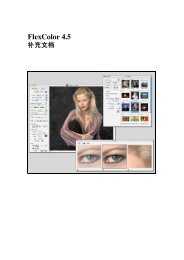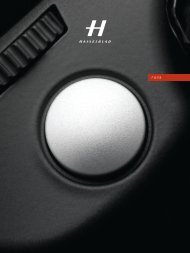User Manual - Hasselblad.jp
User Manual - Hasselblad.jp
User Manual - Hasselblad.jp
Create successful ePaper yourself
Turn your PDF publications into a flip-book with our unique Google optimized e-Paper software.
H4D123ISO/WBFRLight metering and exposure controlTwo primary factors have to be considered when making exposure control choice,namely, metering method and exposure method:Metering method determines in which manner the light measurement is made andhow much of the image is taken into account (Centre Weighted, CentreSpot and Spot).Exposure method involves the parameters and deciding factors about how the lightmeasurement is translated into aperture and shutter speeds. Here the choice is aboutthe camera controls and their effect on the result or suitability for the subject. Includedin this choice is the type of automation too (<strong>Manual</strong> for 100% user control, Aperture priority,Program, etc for automated control).Some methods and modes are much more suited to various situations and applicationsthan others, while some depend to a greater degree on personal preference and waysof working. A discussion of the points to consider in this context is beyond the scope ofthis manual.Since the light measuring system is TTL, filter factors, lens extension / extension ringfactors, etc, are automatically taken into account for average purposes. However, somecombinations of methods and equipment can cause slight discrepancies for various reasonsand therefore for critical work you should make alternative captures to suit personalpreference. Exposures are displayed on the grip display to within 1, 1/2 and 1/3 EV tolerances (dependenton setting). This means that ‘half-stops’ are shown in a form that can differ from moretraditional displays. For example, the position between f/ 8 and f/11 is displayed as f9.5and likewise the position between 1/30s and 1/60s is displayed as 45. Therefore a displayshowing ‘f 9.5 45’ simply means ‘f/9.5 at 1/45 second’. The appearance of an ‘s’ after theshutter speed signifies whole seconds so, for example, ‘32s’ on the display signifies an exposuretime of 32 seconds, not 1/30.45ISO/WBSaveISO & White Balance buttonThe ISO/WB button provides immediate access to ISO and White Balance settings. Thefront and rear control wheels are used to make the desired changes. The settings are automaticallyand simultaneously transferred from the camera to the digital capture unit.Please note that the changes are only displayed on the digital capture unit unit when thesettings have been saved.1) Press the ISO/WB button on the grip.2) To make an ISO setting, turn the front control wheel to choose between:50, 100, 200, 400 and 8003) To make a preset White Balance setting, turn the rear control wheel to choosebetween:Daylight, Shade, Cloudy, Flash, Fluorescent and Tungsten4) To make a <strong>Manual</strong> White Balance setting (not a White balance test exposure),press the Man. (AF) button and then turn the rear control wheel to choose a colortemperature:2000 – 10000 K5) Press SAVE (ISO/WB button) to save the setting. White Balance settings are only approximate color temperature settings. They are onlyused for user convenience when viewing. 3F/3FR files are raw format file and thereforecontain all the information required for correction in Phocus and/or other software, regardlessof the original color temperature at the time of exposure .37


